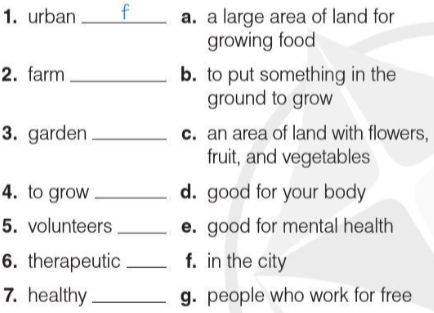Bài tập Unit 4: Food D: Plan a farm or a garden có đáp án
21 người thi tuần này 4.6 1 K lượt thi 4 câu hỏi
🔥 Đề thi HOT:
Đề kiểm tra cuối học kì 1 Tiếng Anh 10 có đáp án- Đề 1
Đề thi giữa kì 1 Tiếng Anh 10 Global Success có đáp án- Đề 2
Đề cương ôn tập giữa kì 1 Tiếng Anh 10 Global Success có đáp án
Đề kiểm tra giữa học kì 1 Tiếng Anh 10 có đáp án- Đề 1
Đề cương ôn tập giữa kì 1 Tiếng Anh 10 iLearn Smart World có đáp án - Part 4: Reading
Đề thi giữa kì 1 Tiếng Anh 10 Thí điểm có đáp án (Đề 1)
Bộ 3 Đề kiểm tra Unit 4 - Tiếng anh 10 iLearn Smart World có đáp án (Đề 1)
Đề cương ôn tập giữa kì 1 Tiếng Anh 10 iLearn Smart World có đáp án - Part 1: Pronunciation
Nội dung liên quan:
Danh sách câu hỏi:
Lời giải
Hướng dẫn làm bài
-People (con người)
- Trees (cây)
- Flowers (hoa)
Lời giải
1.Mario Wezel is a German photographer
2. They show farmers and gardeners
3. They can eat fresh vegetable and baseball in a small garden next to Giants’baseball stadium
4. Prisoners can take gardening class once a week
5. There are about 5.5 billion people living in cities
Hướng dẫn dịch bài đọc
Làm vườn tại thành phố
Mario Wezel là một nhiếp ảnh gia người Đức người mà chụp ảnh cho viện địa lý Quốc Gia. Mario rất thích thú với việc làm vườn tại thành phố, vì vậy rất nhiều ảnh của ông ấy chụp nông dân và thợ làm vườn. Mặc dù làm vườn ở thành phố khác với làm vườn truyền thuống. Nó là khi con người làm ruộng và làm vườn ở giữa thành phố
Mario đã đi đến tất cả các nông trại ở thành phố trên toàn nước Mỹ. Ở Boston, một người đàn ông đã nuôi ong ở trên mái của khách sạn Lenox. Cách sạn sử dụng mật ong trong nhà hàng của nó. Ở San Francisco, có một nông trại nhỏ cạnh sân vận động bóng chạy Giants. Khi mọi người xem trận bóng, họ có thể mua sandwich và với rau tươi.Và ở Washington, D>C, tình nguyện viên có thể giúp làm vườn ở nhà trắng.
Đối với Mario, nông trại thành phố ngạc nhiên nhất của đó là ở nhà tù San Quentin ở California. Nhà tù có vườn và mỗi tuần một lần, tù nhân có thể tham gia lớp làm vườn. Họ học cách trồng cây và hoa. Là việc ở vườn cũng giúp thư giãn.
Các bức ảnh của Mario ở toàn nước Mỹ, nhưng bạn có thể tìm thấy nông trại ở thành phố ở các quốc gia và thành phố khác, như là Tokyo, Lima và Perth. Bở vì khoảng 3,5 tỉ người (một nửa dân số) sống ở thành phố và họ muốn đồ ăn tươi và có lợi cho sức khỏe. Và ngày càng nhiều người nghĩ nông trại ở thành phố là câu trả lời cho sự thiếu hụt thức ăn trên thế giới cũng như là khiến thành phố xanh hơn thoải mái hơn
Lời giải
|
1-f |
2-a |
3-c |
4-b |
|
5-g |
6-e |
7-d |
|
Lời giải
Hướng dẫn làm bài
1. No, I don’t
2.Yes, I do. I clean roads in my neighborhood
3. I do exercise
Hướng dẫn dịch
1. Không, tôi không
2. Có, tôi có. Tôi dọn đường trong khu phố của tôi
3. Tôi tập thể dục
